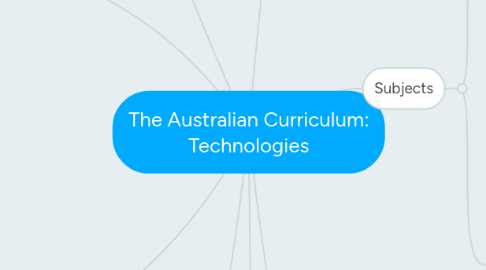
1. Key Concepts
1.1. Abstraction, which underpins all content, particularly the content descriptions relating to the concepts of data representation and specification, algorithms and implementation
1.2. Data collection (properties, sources and collection of data), data representation (symbolism and separation) and data interpretation (patterns and contexts)
1.3. Specification (descriptions and techniques), algorithms (following and describing) and implementation (translating and programming)
1.4. Digital systems (hardware, software, and networks and the internet)
1.5. Interactions (people and digital systems, data and processes) and impacts (sustainability and empowerment).
2. Key Ideas
2.1. Creating preferred futures
2.1.1. Project Management
2.1.2. Thinking in Technologies
2.1.2.1. Systems thinking
2.1.2.2. Design thinking
2.1.2.3. Computational thinking
3. Cross-curriculum priorities
3.1. Aboriginal and Torres Strait Islander histories and cultures
3.2. Asia and Australia’s engagement with Asia
3.3. Sustainability.
4. Band levels: provides learning contexts and expected planning integration.
4.1. Foundation – Year 2
4.2. Year 3 – 6
4.3. Year 7 – 10
5. Achievement standards: Are guidelines of what students should be achieving at a particular year level.
5.1. Content descriptions: What is expected to be taught and learnt.
5.1.1. Content elaborations
6. Curriculum Aims
6.1. investigate, design, plan, manage, create and evaluate solutions
6.2. are creative, innovative and enterprising when using traditional, contemporary and emerging technologies, and understand how technologies have developed over time
6.3. make informed and ethical decisions about the role, impact and use of technologies in the economy, environment and society for a sustainable future
6.4. engage confidently with and responsibly select and manipulate appropriate technologies − materials, data, systems, components, tools and equipment − when designing and creating solutions
6.5. critique, analyse and evaluate problems, needs or opportunities to identify and create solutions.
6.6. These aims are extended and complemented by specific aims for each Technologies subject.
7. Subjects
7.1. • Design and Technologies
7.1.1. Students develop designed solutions for authentic situations using design thinking and technologies.
7.1.1.1. Strands
7.1.1.1.1. Knowledge and understanding
7.1.1.1.2. Processes and production skills
7.1.2. Resources
7.1.2.1. MakersCamp
7.2. • Digital Technologies
7.2.1. Students create, define and use digital solutions through using information systems and computational thinking.
7.2.1.1. Strands
7.2.1.1.1. Knowledge and understanding
7.2.1.1.2. Processes and production skills
7.2.2. Resources
7.2.2.1. Dipity
8. General Capabilities
8.1. Literacy
8.2. Numeracy
8.3. Information and communication technology (ICT) capability
8.4. Critical and creative thinking
8.5. Personal and social capability
8.6. Ethical understanding
8.7. Intercultural understanding.
9. Student Diversity:
9.1. Learning Programs developed from the Australian Curriculum need to be engaging and relevant for all students with consideration of students individual needs, expectations and interests.
9.1.1. Students with disability
9.1.2. English as an additional language or dialect
9.1.3. Gifted and talented students
